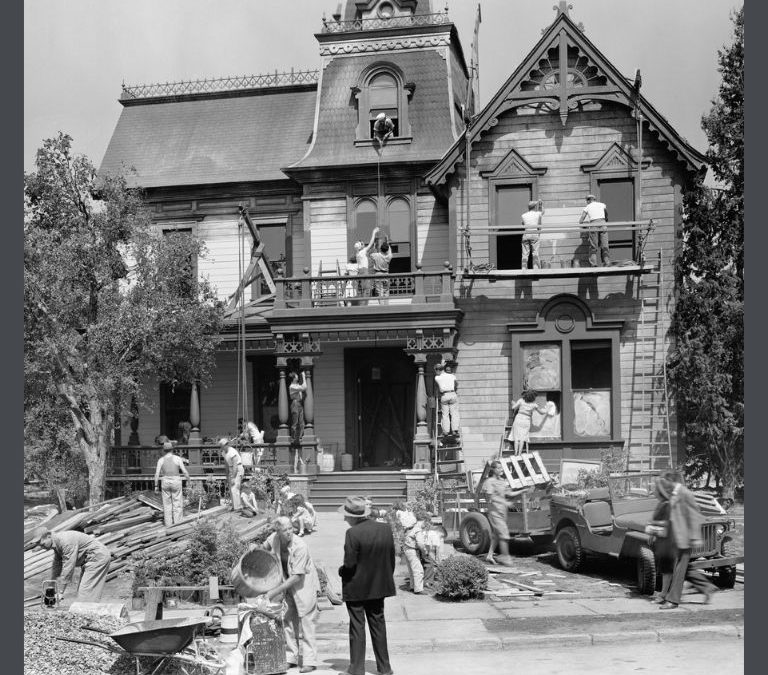
by bungalow101 | Dec 27, 2022 | Doors & windows, The History
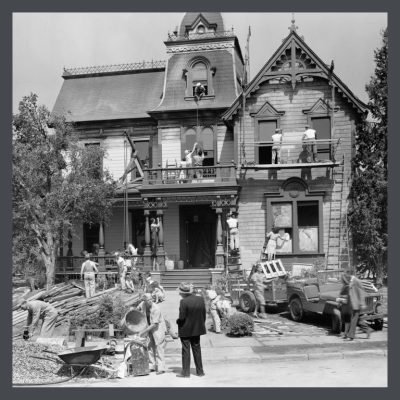 From their framing to their siding to their doors & windows to their built-ins & their flooring, our old houses, are built of old growth wood. Thousands of board feet of it.
From their framing to their siding to their doors & windows to their built-ins & their flooring, our old houses, are built of old growth wood. Thousands of board feet of it.
“Old growth.” What does that mean?
Let’s have a tree history lesson. Fossils show that the first tree-like plants, with vascular systems that transported water & nutrients, allowing the plants for the first time to rise up off the ground (Think moss.) & to form trunks & branches, developed 400 million years ago. Their evolution since then included the development of seeds & true woody stems.
Then,
Over 300 million years ago: The earliest conifers (i.e., cedar, fir, pine, redwoods & others) appear.
67 million years ago: Evidence of the first maple trees.
56 million years ago: Evidence of the first oak trees.
They continued to evolve & to create the great forests that covered most of America, generation after generation contributing to the next as they produced seeds, died & decayed, becoming part of the rich soil of the virgin woodland.
REDWOODS- THE LONGEST LIVING OF OLD GROWTH WOOD
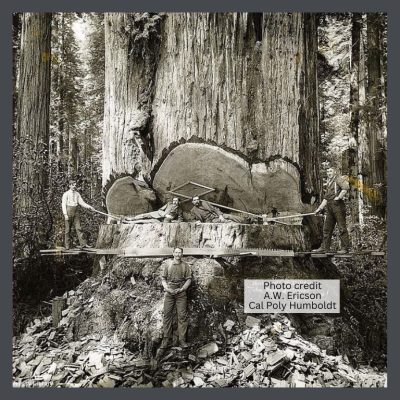 Let’s start with the Redwood, one class being the oldest plants on earth, living from about 800 to 3,200 years. On the west coast, before they were chopped to build our houses, they played an important part in the lives of early indigenous peoples who revered them, building structures from fallen trees. Native elder Minnie Reeves called them “a special gift from the Great Creator. Destroy these trees and you destroy the Creator’s love . . . and you will eventually destroy mankind.”
Let’s start with the Redwood, one class being the oldest plants on earth, living from about 800 to 3,200 years. On the west coast, before they were chopped to build our houses, they played an important part in the lives of early indigenous peoples who revered them, building structures from fallen trees. Native elder Minnie Reeves called them “a special gift from the Great Creator. Destroy these trees and you destroy the Creator’s love . . . and you will eventually destroy mankind.”
When California became a state in 1850, there were nearly 2 million acres of redwood forest. San Francisco was built twice with redwood, before & after the quake & fire of 1906. But the worst was yet to come. During the first half of the 20th Century when California experienced a major building boom, the redwood forest suffered its greatest losses, with trains of lumber heading south as trains of oranges headed north.
Going into the 21st Century, only 5 percent of the old growth forest still stood, thankfully protected on public lands.
In modern times, redwood farms produce wood for lumber, however, this new wood does not have the same high levels of toxic tannins, a type of bitter, astringent chemical compounds which protect the trees from fungus & insects & decrease its susceptibility to rot.
Selective cutting of young trees is permitted on redwood farms but these trees do not have enough age on them to acquire the decay & insect resistant properties of the old growth. If you want the original, old growth wood, you must buy it second-hand, salvaged from old buildings that some uninformed person has chosen to demolish.
OTHER OLD GROWTH CONIFERS IN OLD HOUSES
The Douglas fir forests of the Northwest were treated just as casually. The timber industry, both logging & milling’ developed into a huge industry. The quantities were regarded as unlimited, if they were regarded at all in the push to maximize profit. As harvesting & transportation technologies developed, so did the quantity of forest land destruction increase.
It wasn’t until the 1880’s that conservation of timber supplies was considered. National forests were established & research into good forest practices began.
OAK
 The Domesday Book of 1086, a survey ordered by William the Conqueror to record his holdings, indicated a forest cover of 15%, By the start of the next millennium, this coverage had dropped to 5%.
The Domesday Book of 1086, a survey ordered by William the Conqueror to record his holdings, indicated a forest cover of 15%, By the start of the next millennium, this coverage had dropped to 5%.
In the 17th Century, as thousands of colonists arrived in the United States from England, they placed heavy demands on the forests taking huge trees, some hundreds of years old, of many species for lumber not only for building but also for fuel. Additionally, they cleared lands for agriculture & livestock.
Additionally, after the Industrial Revolution, potash, potassium carbonate derived from burned wood was in high demand in the colonies & in England where they had already decimated their forests. By the early 1800’s, the pre-revolutionary American colonies were providing England with more than 60% of its potash.
The construction boom after WW I, especially during the mid-1920’s, furthered reduced our forest resources. You can read about pine’s story, in the forests of the Eastern U.S., here.
FARMED WOOD VS OLD-GROWTH WOOD
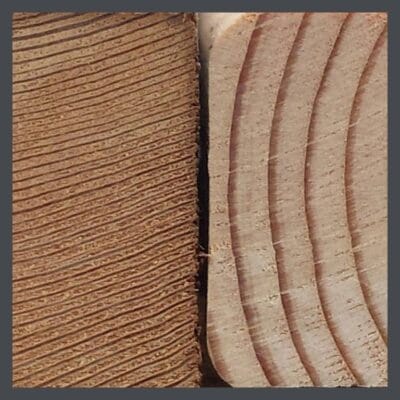 Trees are planted in man-made forests with the purpose of generating a large amount of product, fast. These farms do not replicate the ecology of the natural forest. Generally they are one species only, & all the trees are planted at the same time. The trees are planted in rows spaced to allow maximum sunlight & water exposure so they grow very fast. The old forests allowed trees to grow slowly, putting on more tightly-packed growth rings
Trees are planted in man-made forests with the purpose of generating a large amount of product, fast. These farms do not replicate the ecology of the natural forest. Generally they are one species only, & all the trees are planted at the same time. The trees are planted in rows spaced to allow maximum sunlight & water exposure so they grow very fast. The old forests allowed trees to grow slowly, putting on more tightly-packed growth rings
Because of this, new growth wood does not have the strength, stability nor the decay & insect repelling properties of old growth wood- not to mention the beauty. But. stick with me here. I have a theory about additional environmental factors that made the virgin forests a much better place for trees.
The conditions in the old forests had evolved over millions of years. Co-evolution is the evolving of all the parts of an ecosystem to assist each of its parts survive better. i.e., evolutionary change over time, benefiting each interacting member, usually involving different species. Tree farms lack this dynamic. They are the new kids in school without a support system, not oriented to their environment, & growing in unnatural conditions.
The virgin forest is home to many tree species as well as hundreds of different insects, animals & microbes. All of these organisms have made reciprocal adaptive changes in cooperation with one or more other species, over the millennia, helping one another to survive with greater & greater efficiency.
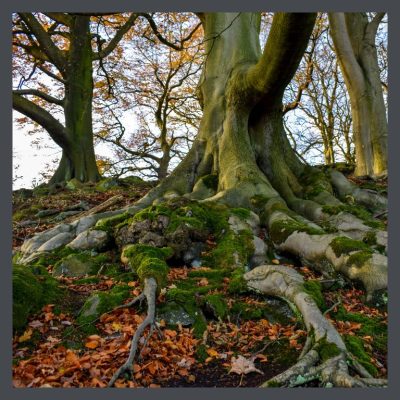 Much of this mutual adaptation involves microorganisms, the fungi that break down the fiber of the dead trees & turn them into nutritious soil, but also form a communication network for the trees. Watch this short video by National Geographic that explains how trees connect & share with one another.
Much of this mutual adaptation involves microorganisms, the fungi that break down the fiber of the dead trees & turn them into nutritious soil, but also form a communication network for the trees. Watch this short video by National Geographic that explains how trees connect & share with one another.
Trees do not stand alone, competing with one another for sunlight, water & nutrients. Rather, the forest is almost like a single organism, the different trees interacting with one another, both within & outside their own species, through their roots & the fungal networks that connect these roots. They exchange communication & nutrients through this network, with the larger, old Mother trees forming the hubs. As an example, Douglas firs share excess sugars with the leafless birches in the spring & fall, & in return, the birches send sugars to the Douglas-firs in the summer, via the fungi underground.
Here’s my crazy theory. The health of the human body depends on the quantity & diversity of the microbes that live in the gut. To build a strong, healthy body, one needs a strong healthy microbiome- the colony of microorganisms within the body. This is a lovely short video of 2 Stanford researchers who have discovered much of what is known in this science. They have a big picture of bacteria over the fireplace in their home.
My hypothesis is that lumber from a tree grown in the virgin forest is better, stronger, more stable, more decay & insect resistant not just because it is old & bigger, but because it has grown up with a Mother, a family, neighbors & friends in the form of an active ecosystem that has had millions of years to get it right. “It’s not better because it’s old, it’s old because it’s better.”
What do you think?
FOR MORE INFORMATION ON OLD GROWTH WOOD, VISIT OUR OLD HOUSE RESTORATION VIDEOS- OLD GROWTH WOOD here.
 STAY IN THE BUNGALOW KNOW!!!
STAY IN THE BUNGALOW KNOW!!!
Sign up for our newsletter & receive our FREE E-book, 7 VITAL Things to Do Before You Hire a Contractor.
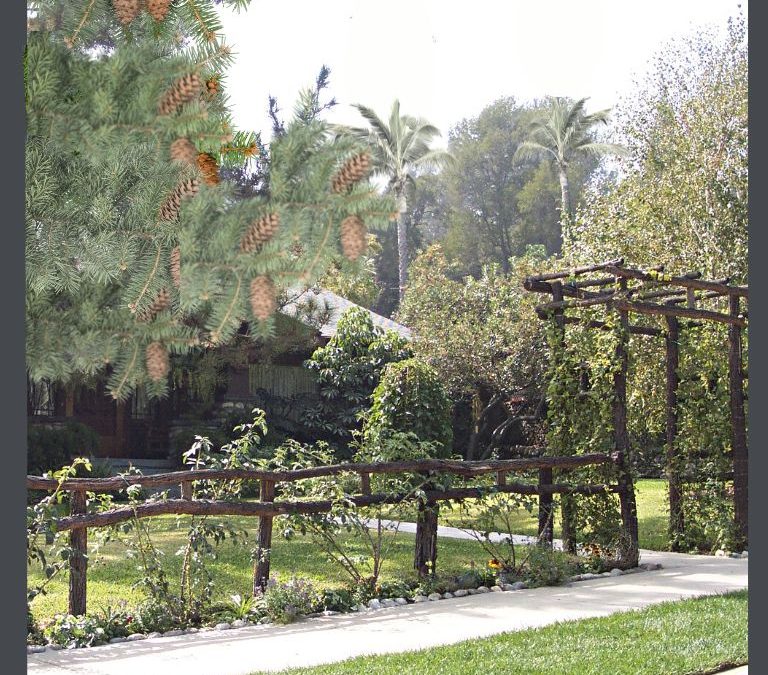
by bungalow101 | Dec 26, 2022 | Doing it the right way, Features
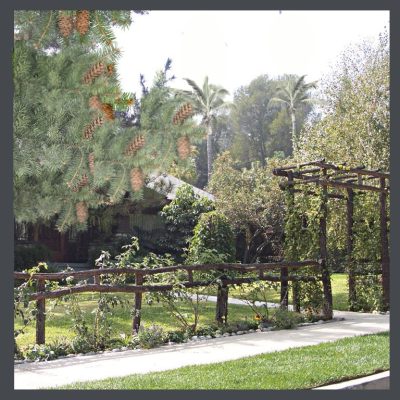 The story begins with my love affair with the Alfred W. & Grace D. Hare House, a beautiful Craftsman, in Eagle Rock, a bungalow neighborhood in N.E. Los Angeles. Once an incorporated town in its own right, Eagle Rock is just west of Pasadena & was clearly influenced by the architecture being built there.
The story begins with my love affair with the Alfred W. & Grace D. Hare House, a beautiful Craftsman, in Eagle Rock, a bungalow neighborhood in N.E. Los Angeles. Once an incorporated town in its own right, Eagle Rock is just west of Pasadena & was clearly influenced by the architecture being built there.
The entrance to the property is through an arbor that I had built with saplings that were so green that leaves kept growing long after the fence was constructed. An arroyo rock border lined the sidewalk & roses grew intertwined through the sapling fence. There’s a great, full page image of the arbor in BUNGALOW DETAILS: Exterior, on page 190
The rocks came from the nearby Arroyo Seco (which in Spanish means “dry gulch”) a canyon between Eagle Rock & Pasadena. This rock is a common material seen in houses in this area & clearly shows their place in the world.
My next-door-neighbor retired & got herself a chainsaw, Every time I heard the buzzing start-up, I’d grab my keys & head for the nursery to buy another tree. I ended up with a small grove of birches in the front & a shaggy, grafted tree that looked like a parasol under which fairies could dance, when it was first installed but turned into Cousin Itt as it grew. The house is on 1 1/2 lots & is set well back from the street, so the Addams family representative, the huge, aged pine & the new birches made a nice little forest.
MY ARTS & CRAFTS GARDEN
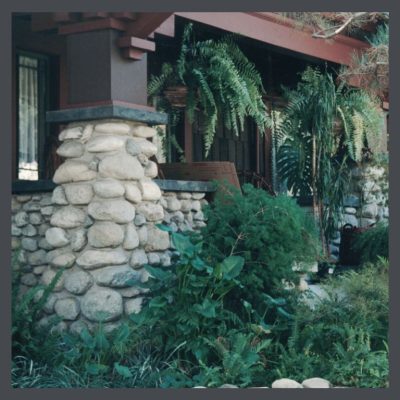 I also used the same rocks to form a path from the driveway to the front walk. I installed baby’s tears (Soleirolia soleirolii) a mossy appearing tropical perennial with tiny, tiny leaves between the path & the border. They were very soft & sweet & I coaxed them to grow so that they would provide a natural woodland look. A week before my mother was supposed to arrive to see the house for the first time, my gardener edged them so they were level on top & flat against the border. I am a plant whisperer but I admit that during that week I was more of a plant cheerleader & probably even a plant sergeant, alternating cheering & commanding them to grow back into gentle, fluffy mounds before my mom’s arrival.
I also used the same rocks to form a path from the driveway to the front walk. I installed baby’s tears (Soleirolia soleirolii) a mossy appearing tropical perennial with tiny, tiny leaves between the path & the border. They were very soft & sweet & I coaxed them to grow so that they would provide a natural woodland look. A week before my mother was supposed to arrive to see the house for the first time, my gardener edged them so they were level on top & flat against the border. I am a plant whisperer but I admit that during that week I was more of a plant cheerleader & probably even a plant sergeant, alternating cheering & commanding them to grow back into gentle, fluffy mounds before my mom’s arrival.
Inspired by the origins of the Arts & Crafts Movement, I planted an English garden. Arroyo rock bordered the garden beds which I enlarged & planted with shade loving plants on the shady side & plants that looked like shade loving plants on the other side. It was very difficult! Los Angeles is not England. Los Angeles is a desert & plants easily fry in the sun, so I had to stretch my wits to fill a bed that got nuked every day with plants that could have maybe been in an English cottage garden.
A great deal of my planning was centered on choosing what I would want to cut, to bring in the house. I love old flowers, so I chose calla lilies & several different types of ferns so that I would have greens. I grew roses in honor of my mother & my grandmother. My grandmother was an accomplished rosarian, & in 1930, was certified as a rose judge.
THE HOUSE
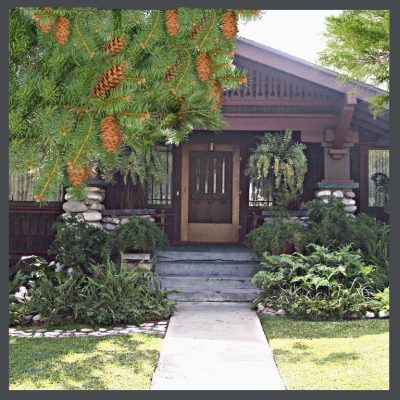 The centered, front-gabled porch is supported by massive timber framing & arroyo stone piers. A free-form arroyo stone chimney is on the east side. Sadly, I have no pictures of my chimney, but you can see it in Jane Powell’s book BUNGALOW DETAILS: Exterior, on page 57. It’s chunky!
The centered, front-gabled porch is supported by massive timber framing & arroyo stone piers. A free-form arroyo stone chimney is on the east side. Sadly, I have no pictures of my chimney, but you can see it in Jane Powell’s book BUNGALOW DETAILS: Exterior, on page 57. It’s chunky!
Typical of Southern California Craftsman style, as one of the earlier houses built, the Hare House helped set the style for later homes in Eagle Rock. Its solid massing & low horizontal profile, is boldly embellished with honest decorative elements, employing simple & natural building materials. As celebrated by the Arts & Crafts Movement, there are many connections from the outside to the inside, with the inviting porch & the sunroom & the many large windows, both casement & doublehung in every room of the house.
The entry features a centered Douglas fir door with 4 beveled lites. We added a screen door (not original) of quartersawn oak with brass screen. You can read about the door & the tiny faces who loved to look out of it here.
The shingle siding was stained when i purchased the house. I hire an inexperienced painter who had slapped a coat of paint on it by the time I arrived home from the office. We had chosen colors together & I thought that he noticed that I was showing him stain samples, but he did not. There is a good chance that he had never stained a house & didn’t know that you could. It broke my heart. I felt like I had betrayed the house.
THE BUILDER OF MY CRAFTSMAN IN EAGLE ROCK
The original owner (through 1923) Rev. Alfred W. Hare & his wife Grace D. Hare made significant contributions to the community of Eagle Rock & the City of Los Angeles.They were both active in the cultural, social & religious life of the town. Local papers of the time feature many stories of their travels, their house guests & their participation in events on behalf of the town’s various social organizations, such as the Women’s Club, the Elks, the Red Cross & the Near East Relief work after the war.
Ordained as a clergyman of the Congregational Church in 1896, Hare moved to Eagle Rock in 1909 as pastor of the shuttered Eagle Rock Congregational Church. Soon after, due to his inspired success of the church, Hare oversaw the construction of a new church building.
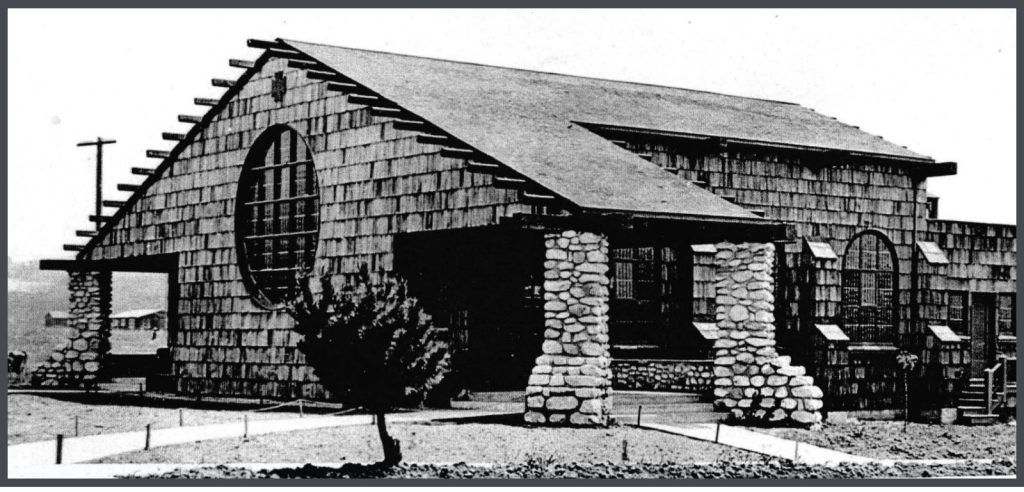
Sadly, this church, an extraordinary example of Arts & Crafts design, is no longer standing. I have been unable to track down both the architect of the house & of the church. To my eye, the house & the church were not drawn by the same hand. I would love to know your opinion of this.
After 1912, he was the pastor at other churches in Los Angeles, notably 27 total years at Park Congregational Church in Angeleno Heights.
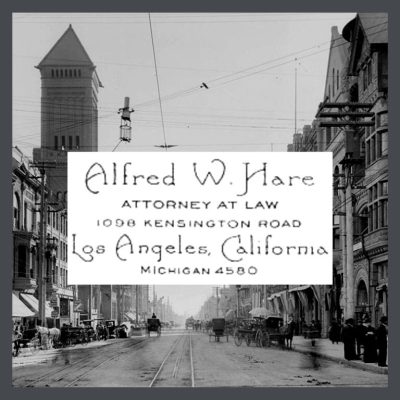 Admitted to the Los Angeles County Bar Association in 1912, Hare founded the large & successful law firm of Hare & Walden situated in downtown Los Angeles, which was connected by trolley to Eagle Rock. The little home office, with its built-in desk & fireplace was probably well-used by Hare, writing sermons, counseling parishioners & then, after he began practicing law, working on cases that he brought home from the office so that he could be with his wife, Grace.
Admitted to the Los Angeles County Bar Association in 1912, Hare founded the large & successful law firm of Hare & Walden situated in downtown Los Angeles, which was connected by trolley to Eagle Rock. The little home office, with its built-in desk & fireplace was probably well-used by Hare, writing sermons, counseling parishioners & then, after he began practicing law, working on cases that he brought home from the office so that he could be with his wife, Grace.
Mrs. Grace Dunsmoor Hare had been a “successful & popular” teacher & was the daughter of Charles Dunsmoor, who was County Clerk of Los Angeles County & California State Bank Commissioner. Both Mr. & Mrs. Hare were revered leaders in the realms of social activism & philanthropy in their community of Eagle Rock.
Learning these things about them helped to explain the house. Though one of the finest homes in the neighborhood, it was situated well away from the grah-ah-ahnd street of the town, Hill Drive. Learning of Reverend Hare’s astute ability to handle money -he helped several churches whose congregations he led to tear up their mortgages- my surmise is that he thriftily chose a less pricey, but large & beautiful lot on which to build.
The house, at 1950 square feet had only 2 bedrooms. In none of my research on him have I seen any evidence of children. In later years Grace was sickly & I wonder if her maladies could have affected her fertility. By the time the house was built, they had been married for 7 years & had probably stopped hoping to grow their family.
 The public areas were clearly designed for entertaining with a large living room & dining room, as well as a sunroom. I can easily imagine gay fundraisers for the Women’s Twentieth Century Club building fund to have taken place there, with Alfred playing the guitar & the 2 of them singing, perhaps accompanied by his sisters who wrote songs & skits to contribute to the effort.
The public areas were clearly designed for entertaining with a large living room & dining room, as well as a sunroom. I can easily imagine gay fundraisers for the Women’s Twentieth Century Club building fund to have taken place there, with Alfred playing the guitar & the 2 of them singing, perhaps accompanied by his sisters who wrote songs & skits to contribute to the effort.
Almost 100 years later, I was a member of Club & participated in fundraising events to restore & preserve the beautiful building. Again, I wonder at the architect because all the members of the Hare family, Alfred, Grace & his 3 sisters were instrumental in the fundraising that enabled it to be built & they possibly would have had some influence in its design.
It was an honor & a privilege to hold the stewardship of this beautiful home. When I restored it, I kept the Hares in mind & strove to create make choices that would please them & create a space in which they would feel comfortable. The woman to whom I sold the house held them in the same regard & the remaining restoration that she performed, was done with the same reverence, for the family, the neighborhood & the period.
TIP: TO READ MORE ABOUT MY LOVE AFFAIR WITH THE HARE HOUSE, CLICK HERE.
 STAY IN THE BUNGALOW KNOW!!!
STAY IN THE BUNGALOW KNOW!!!
Sign up for our newsletter & receive our FREE E-book, 7 VITAL Things to Do Before You Hire a Contractor.

by bungalow101 | Dec 20, 2022 | Doing it the right way
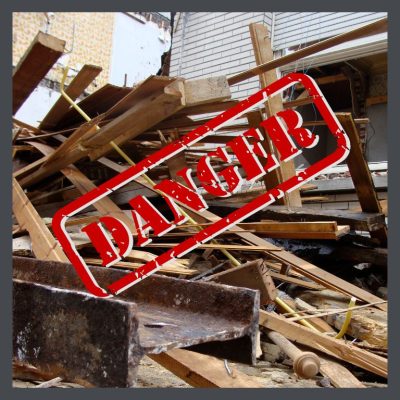 It’s not easy to stay healthy when restoring an old house. Increased demands on your time, your finances, the toxins in the materials you will demo & install, & the stress of making constant decisions, facing too many surprises mean that to stay strong, you need to maybe spruce up your lifestyle choices to compensate. And maybe you have to do this without no kitchen!
It’s not easy to stay healthy when restoring an old house. Increased demands on your time, your finances, the toxins in the materials you will demo & install, & the stress of making constant decisions, facing too many surprises mean that to stay strong, you need to maybe spruce up your lifestyle choices to compensate. And maybe you have to do this without no kitchen!
We already know that I think I’m everybody’s mother, but hear me out because I know some stuff. I learned it from my mother who learned it from her mother who, yep, learned it from her mother. I hail from a long line of totally badass women!
I also tend to be a bit of a natural health geek. As stated, I come by it honorably, but I also just tend to be a problem solver with a great deal of curiosity & a little help from my friend Dr. Google. In addition, I enjoy helping people so I have made it my business to learn things that I feel will benefit others. (Little boasting here- I got 35 lbs. off my formerly chubby hubby & got his 70 year old blood work looking like that of a 20 year old.)
PIGS & OLD HOUSES
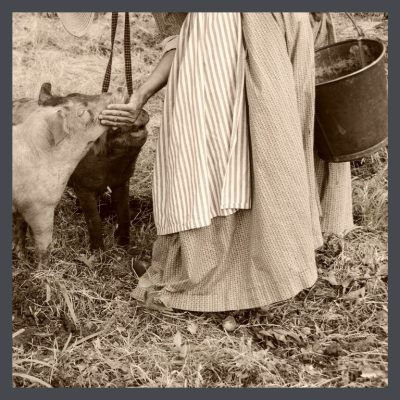 My grandmother, Sarah Emmeline Martz was a farmer’s wife who cooked for her family every day & tossed the slop to the pigs. During one season of household sniffles she noticed how healthy the oinksters were, compared to her own family, & considered what was in that slop. What she noticed was that she was giving the piggies the outsides of the food- the peels, the parts that grew in closest contact with the soil of her garden. Being a farmer’s wife, she knew where the nourishment for plants came from- the soil- & wondered if maybe she was throwing out the most nutritious part of her family’s food.
My grandmother, Sarah Emmeline Martz was a farmer’s wife who cooked for her family every day & tossed the slop to the pigs. During one season of household sniffles she noticed how healthy the oinksters were, compared to her own family, & considered what was in that slop. What she noticed was that she was giving the piggies the outsides of the food- the peels, the parts that grew in closest contact with the soil of her garden. Being a farmer’s wife, she knew where the nourishment for plants came from- the soil- & wondered if maybe she was throwing out the most nutritious part of her family’s food.
Decades later, my mother considered it a criminal act to use a peeling device. During my childhood I heard daily, “That’s where the nutrition is!” And tell us once again the story of Sarah Emmaline & the pigs.
Foods are the building blocks of our bodies whatever health problems we are experiencing or wanting to stave off are generally caused by inadequate nutrition & can be solved with making sure that we get sufficient nutrition. Recent scientific discoveries in labs all over the world as well as clinical trials have supported this belief and explained why it is true. It’s not just moms!
SO, HOW DOES FOOD SUPPORT LIFE?
 The answer is in the beneficial tiny living beings – microorganisms- that live in and on our bodies, especially our guts. Each one of us harbors a unique set, our own community of microorganisms- our microbiota- microscopic life. Our own, personal microbiota, our own group of microorganisms differs from that of any other person as much as our own fingerprints do. The effects of our microbiota on our bodies, are diverse & profound. I am going to concentrate on the microbiota living in our guts to address the subject of how to stay healthy when restoring an old house.
The answer is in the beneficial tiny living beings – microorganisms- that live in and on our bodies, especially our guts. Each one of us harbors a unique set, our own community of microorganisms- our microbiota- microscopic life. Our own, personal microbiota, our own group of microorganisms differs from that of any other person as much as our own fingerprints do. The effects of our microbiota on our bodies, are diverse & profound. I am going to concentrate on the microbiota living in our guts to address the subject of how to stay healthy when restoring an old house.
I have a YouTube playlist that has a great deal of information on this subject as well as many tips on how you can stay healthy when restoring your old house. I have attempted to include only videos that provide an introduction to the subject, but some of them may use medical term that yu have never encountered. If this is the case & you’d like to learn more about the subject, contact me & I will send you the glossary of terms that I created for myself when I was doing my own study on gut health. I am just a student myself, but I think that I have made it all the way to second grade!
HOW MICROBES HELP US STAY HEALTHY WHEN RESTORING AN OLD HOUSE
Here are some of the relationships that have been found between us & these microorganisms:
- Mental soundness- in addition to increasing of energy for working, taking care of our families & running a construction crew, microorganisms directly affect mood. The gut is described as being the “second brain” & the imbalance of microorganisms is directly correlated to such things as insomnia, anxiety, depression & our reaction to that $14,000 bid.
- Balancing hormones- These microbes control the endocrine system, and support or inhibit hormonal harmony, including estrogen, insulin & thyroid. This is especially important as we age, approaching menopause & beyond, when our endocrine system is especially taxed. The endocrine & the nervous systems work together to keep us sharp & jolly.
- Increase energy levels- By helping us absorb & utilize nutrients & to get rid of toxins, energy levels improve, allowing us successfully take on challenges such as getting that $14,000 bid to rebuild the chimney.
- Immune system- microorganisms help our bodies fight off disease by defending us from pathogenic (disease causing) organisms as well as allergens. They are the super women of the immune system.The demo process involves exposing & propelling allergens & pathogens into the air YOU BREATHE. Dust, mold, insect & animal droppings- it’s all there. (And don’t forget that PPE. You’re living on a jobsite.)
- Reduce yeast & urinary tract infections. The good bacteria once again save the day by preventing disease causing bacteria from adhering to the bladder wall. I hate to be indelicate, but for those times the only bathroom bathroom is being reno’d…And incidentally-
- Weight control- Scientists in labs have created obese mice from normal sized mice by giving them microorganisms (tiny living organisms) from obese humans, & have created lean mice by giving them microorganisms from skinny folks.
- Research has shown that a proper balance of microorganisms in the gut contributes to weight loss. What’s in your gut determines how you will process calories & how you will store them.
- The heart – Having a healthy gut allows cholesterol to be excreted by the bowel instead of accumulating at high levels in the bloodstream.You can see that these are some active critters, helping you to stay healthy when dealing with the rigors of renovation! I have a YouTube playlist that has a great deal of information on this subject as well as many tips on how you can stay healthy when restoring your old house.

STAY IN THE BUNGALOW KNOW!!!
Sign up for our newsletter & receive our FREE E-book, 7 VITAL Things to Do Before You Hire a Contractor.
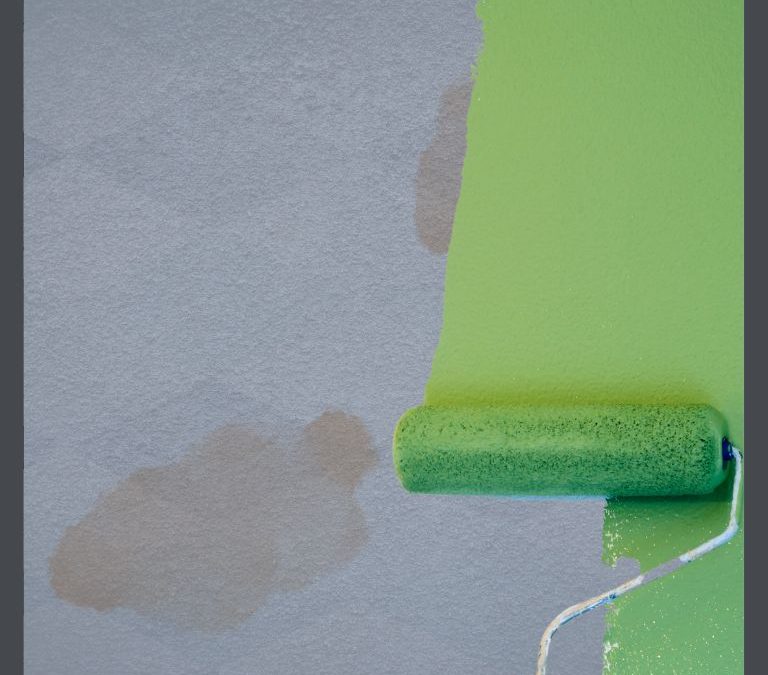
by bungalow101 | Dec 18, 2022 | Kitchens
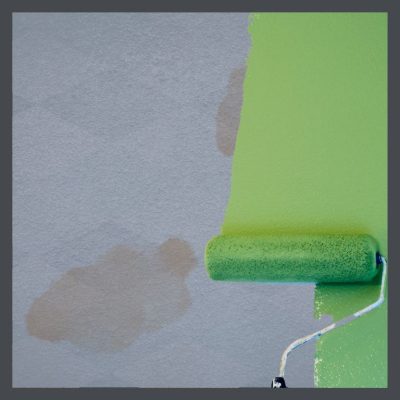 The reason I’m even proposing the weird idea of painting a bungalow linoleum floor is because lino wears out. Through decades of footsteps in some of the highest traffic areas of the house, roller skates & doggy toenails, abrasion can annihilate the printed pattern leaving you with a rough, gray surface. Even worse, age can uncover sections of the jute or burlap base, & even one layer down, the mastic that glued it to the subsurface. Adding to the delight are the ineradicable stains of unknown origin. (A whole chicken maybe? They are dang slippery.)
The reason I’m even proposing the weird idea of painting a bungalow linoleum floor is because lino wears out. Through decades of footsteps in some of the highest traffic areas of the house, roller skates & doggy toenails, abrasion can annihilate the printed pattern leaving you with a rough, gray surface. Even worse, age can uncover sections of the jute or burlap base, & even one layer down, the mastic that glued it to the subsurface. Adding to the delight are the ineradicable stains of unknown origin. (A whole chicken maybe? They are dang slippery.)
Sadly, the lino patterns you see in Jane Powell’s book, LINOLEUM, are no longer manufactured. Twenty-five years ago, you could pay a ridiculous amount of money for a roll of new old stock but the supply of this too went the way of the dinosaur. I used to visit Linoleum City in Los Angeles to drool over their old lino collection. No mo’.
You may have a floor that is just suffering in a more highly trafficked area, but have some pattern left in other parts of the floor. Should this be the case, you can just touch up the rough areas with acrylic paint to match the existing pattern, & clean & wax your whole floor.
But, at a certain point, a lino floor is over. O-V-E-R. The pattern on mine was entirely gone. It was just a sea of dirty gray. While I relentlessly advocate for preserving historic materials, a kitchen floor needs to be cleanable & even with a good scrubbing followed by waxing, (I tried it, fingers crossed that I might at least get some improvement. Nah. Still gray, rough & grotty as heck.) mine was nasty. There was nothing left to coax back into utility, let alone beauty.
So what’s a lino loving bungalow girl to do?
MY BUNGALOW LINOLEUM FLOOR SOLUTION
 In 1980, I had noticed that any paint I got on the very old & worn (& hideous & impossible to clean) lino floor in my rented bungalow, was too stubborn to remove, I thought, “Gee, I could paint this puppy!”
In 1980, I had noticed that any paint I got on the very old & worn (& hideous & impossible to clean) lino floor in my rented bungalow, was too stubborn to remove, I thought, “Gee, I could paint this puppy!”
And I did.
It was very inexpensive to do (a prime consideration, for a vintage clothing store proprietress) & a piece of cake. It was also a very fun project because it quickly changed something scary & germy to something lovely & safe.
The finished product looked great, was very easy to clean with my duster & my sponge mop, held up beautifully & looked perfect with the faux lino floor cloth I had made. I felt like if I were to drop a piece of food on it, or my cat were to cough up a big hairball, they would no longer become permanent, rotting parts of the floor! (Euwh!)
THE MANY CAVEATS ON PAINTING A BUNGALOW LINOLEUM FLOOR
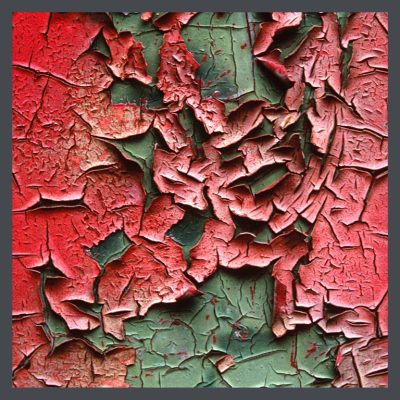 Even though I had done this process successfully, material formulas have changed radically in the past 40 years (bad) due to environmental concerns (good). Additionally, having painted no design to my 80’s floor, I had ended up with a very flat paint surface. (I used a stenciled canvas floor cloth to make a faux lino rug to fancy it up.) And, I was married to a chemistry major who had sanded & coated 1,000+ floors & was using perfectly calibrated, state-of-art equipment. I’m thinkin’ that maybe you don’t have someone living in your home with these qualifications, nor this equipment (though I’m sure he has his own fine equipment.) So, I wanted to check out these aspects with Earl, my tech guy at Ben Moore, for advice on the painting of a bungalow’s linoleum floor. Earl immediately said, “Don’t do it.”
Even though I had done this process successfully, material formulas have changed radically in the past 40 years (bad) due to environmental concerns (good). Additionally, having painted no design to my 80’s floor, I had ended up with a very flat paint surface. (I used a stenciled canvas floor cloth to make a faux lino rug to fancy it up.) And, I was married to a chemistry major who had sanded & coated 1,000+ floors & was using perfectly calibrated, state-of-art equipment. I’m thinkin’ that maybe you don’t have someone living in your home with these qualifications, nor this equipment (though I’m sure he has his own fine equipment.) So, I wanted to check out these aspects with Earl, my tech guy at Ben Moore, for advice on the painting of a bungalow’s linoleum floor. Earl immediately said, “Don’t do it.”
I’m a flooring professional so I lack the dewy optimism of the inexperienced. I have seen floors peel, scratch, bubble, pretty much perform tragically in multiple ways, so I always err on the side of caution when dealing with any new material or process. I read everything the manufacturer says in their tech materials. I follow that with a question- filled call that usually gets me transferred from customer service to the tech guys. This is why I love Earl. He’s a tech guy who works the customer service phones. A jewel!
Here’s why he said this & also why the article doesn’t just end right here.
IT’S ALL ABOUT THE BOND
 You are about to become a paint expert. This will serve you well as an old house owner because this is not the only time that you will be dealing with applying paint. And if you want to know more, you can go here.
You are about to become a paint expert. This will serve you well as an old house owner because this is not the only time that you will be dealing with applying paint. And if you want to know more, you can go here.
Adhesion is always an issue, especially in high-traffic areas. My husband chemically stripped the floor & then scuff sanded the very old linoleum in our bungalow kitchen to remove any materials that might have been applied to it, such as my freshly applied wax (Oops!) & also any cleaning materials that might have left a residue, in order to prep for painting. He then, using 180 grit paper, sanded off any dirt that was ground into the surface & give it some “tooth.”
Tooth is desired when you wish to create a mechanical (as opposed to chemical) interlocking/bonding of materials, i.e., the paint & lino marriage. So, you scuff the lino to create tiny cavities (tooth) on its surface to increase the contact area. The wet paint you apply then displaces any air between the paint itself & the lino & the 2 lock together. I definitely had a tooth advantage with my old lino because it was OLD, & hadn’t been smooth for decades.
A mechanical bond is not as strong as a chemical bond & herein lies the fragility of your floor.
Let’s also talk about chemical bonding when painting your bungalow linoleum floor, because you’re going to be forming those bonds too when you paint it.
THE 3 COMPONENTS OF PAINT & WHY YOU NEED TO KNOW
Most paints have 3 main components called the pigment, the binder, and the solvent.
The pigment is the color chemical in a paint. Binders are incorporated to glue the pigment particles to each another, & also to make the particles stick to the surface you’re painting. Solvents, not surprisingly, dissolve stuff. This material makes the pigment & binder into a thinner & less viscous (more easily flowing) liquid so that it will spread evenly. For the purpose of ease on your own self & ease on our fragile environment, I am going to suggest the use of water-based paints, in which the solvent is water.
A couple more concepts you need to understand are drying & curing. If your room is well-ventilated, your paint will feel dry to the touch within minutes after application. However, it is dry only on its surface. Curing, the evaporation of all the water (binder) in the paint can take days. The 2 types of bonds determine the steps that you will do as you cruise through your painting process.
 If you apply a second coat on when your first is just dry to the touch- not cured- you will get a chemical bond between the 2 coats. As the water (binder) evaporates, the like chemicals of the pigment & the binder will be attracted to each other & form what could be considered a single coat. It’s a very strong bond.
If you apply a second coat on when your first is just dry to the touch- not cured- you will get a chemical bond between the 2 coats. As the water (binder) evaporates, the like chemicals of the pigment & the binder will be attracted to each other & form what could be considered a single coat. It’s a very strong bond.
It’s why your nail polish peels down to the nail, instead of peeling in single layers.
What this means is if your weekend project goes into the next weekend, your paint will be too dry to form this chemical bond with the next coat you apply, so, you are going to need to give the original coat some “tooth” in order for your next coat to adhere with a mechanical bond. That mechanical bond is achieved with a bit of scuffing, so that you aren’t going in on top of such a smooth surface.
This is a kitchen, the most heavily trafficked room in your house, & yeah, you need to do it right so that it will take the wear. If you take all the right steps when you apply the materials the first time, you are much less likely to have problems later on.
WHY I’M CONTINUING ON DESPITE BEN MOORE’S ADVICE & A TON OF CAVEATS
A. My advice is for real linoleum only.
B. If you want to paint a new lino floor, that you will install to paint, realize that it is risky. It’s not an inexpensive material, & the labor to install it is pretty pricey too. Most importantly, new lino is made with a coating that repels, well, anything you wouldn’t want to stick to. For you, I’m am recommending that instead you choose cool patterns in cut linoleum that are fitted together like a puzzle to make your overall design. You can see an example of what can be done here.
C. If your floor is old & funky as mine was, prepping it thoroughly to create a proper bond, you can improve its look & functionality greatly. How long will it last? Who knows?
D. I’m assuming that you are performing all the testing that you need to on existing materials for asbestos & lead, & mitigating as needed. Let’s talk about asbestos. In this article by Bob Vila he talks about asbestos in linoleum. Give it a read before you start.
E. For every product that you are using, you’re studying your Safety Data Sheets & using correct PPE correctly.
SO HERE’S HOW TO PAINT YOUR BUNGALOW’S LINOLEUM FLOOR
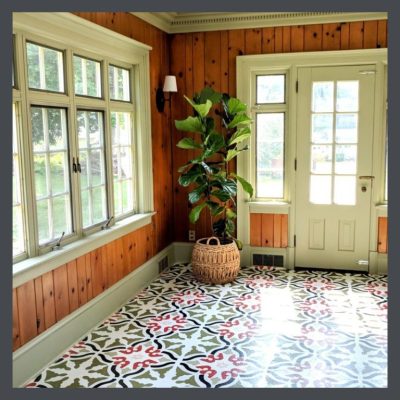 0. Mend any boo-boo’s. I am not going to try to teach you to do this because I have never mended a floor. I am going to suggest some links of pages that look like they might know what they’re talking about.
0. Mend any boo-boo’s. I am not going to try to teach you to do this because I have never mended a floor. I am going to suggest some links of pages that look like they might know what they’re talking about.
Wisconsin Historical Society
They tell you a brief history of the development of lino & give you instructions of fixing problems. This is not the only method, so here’s another one.
Porter’s Environment & Cleaning Services
This one addresses rips & tears.
ehow
This one is about how to tack down curling edges.
Week&
In this one you learn how to patch whole areas that are missing.
1. Choose your pattern & your colors. Think about coordinating your floor with your curtains. If you are going to stencil your curtains, or even if you’re not & you’re looking for pattern ideas, head on over to my article on window treatments where you will find links to vendors of lovely A & C stencils. You can use my article on choosing paint colors if you need any help. The reason I say this is because your stencil colors are more limited while a trip to Ben Moore will yield any custom color that you could possibly desire.
2. Jane Powell’s LINOLEUM has some amazing vintage patterns in it, for inspiration, or just to out-&-out copy them. You can use a simple graphics program, building it layer by layer & employing their graph feature to transfer it to real life
3. Zip on over to WELCOME TO REALITY DAYDREAM where Beth has it all figured out. I am not about to re-invent any wheels! She says that the paint on her floors is holding up well 4 years after she wrote the article, so she must know something!
TIP: Should you not be convinced of the utter coolness of lino, watch these videos.

STAY IN THE BUNGALOW KNOW!!!
Sign up for our newsletter & receive our FREE E-book, 7 VITAL Things to Do Before You Hire a Contractor.
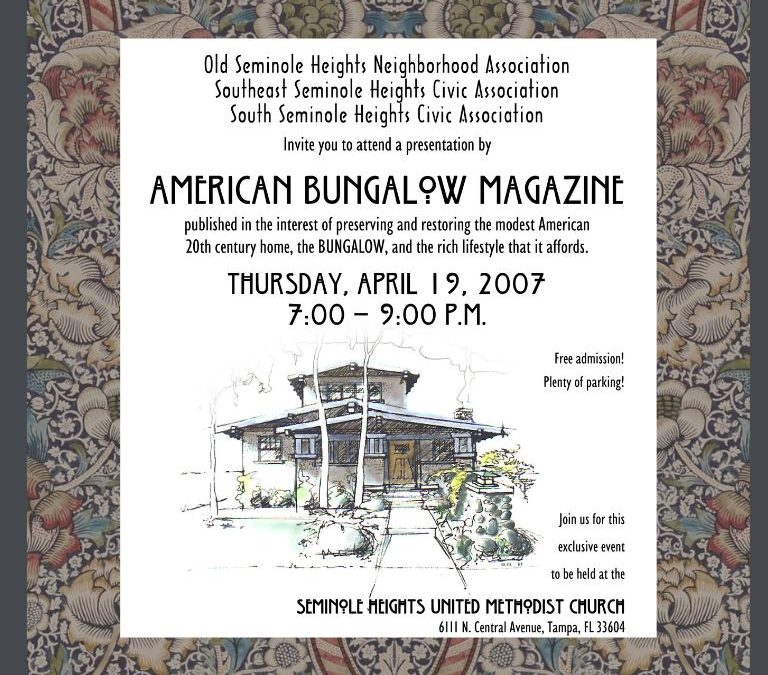
by bungalow101 | Dec 10, 2022 | Preservation groups, The History
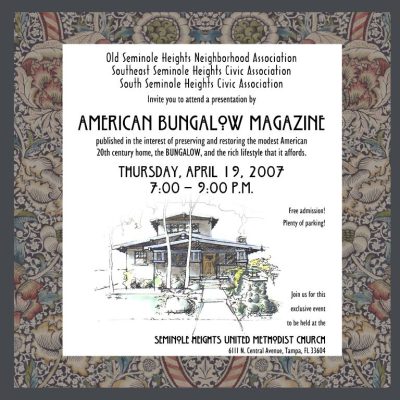 What seems like a lifetime ago, with a great amount of help from my friends in the 3 areas that make up the bungalow neighborhood of Seminole Heights, in Tampa, Florida, I produced an American Bungalow Magazine event. I had coaxed, cajoled, pleaded with the editor to have genius photographer, Alex Vertikoff come to Central Florida to shoot our houses. I coordinated with 4 other neighborhoods in Tampa, St. Petersburg & Lakeland to make it worth their while to drive all the way across the country. Publisher John Brinkmann came to speak to us at a wonderful event in our historic church.
What seems like a lifetime ago, with a great amount of help from my friends in the 3 areas that make up the bungalow neighborhood of Seminole Heights, in Tampa, Florida, I produced an American Bungalow Magazine event. I had coaxed, cajoled, pleaded with the editor to have genius photographer, Alex Vertikoff come to Central Florida to shoot our houses. I coordinated with 4 other neighborhoods in Tampa, St. Petersburg & Lakeland to make it worth their while to drive all the way across the country. Publisher John Brinkmann came to speak to us at a wonderful event in our historic church.
I had been a devotee of American Bungalow for a number of years. They had attended our first home tour in Eagle Rock & published a beautiful article on the Hanson Puthuff house, displayed on the poster to the left.
In my Tampa neighborhood, I enjoyed the privilege of being the magazine distributor. Every quarter the magazines would arrive in a big box, & I would peddle them around the neighborhood at events & meetings & deliver to people’s homes when requested. It was a great way to meet folks, educate Tampa on historic houses & support the valuable work of the magazine.
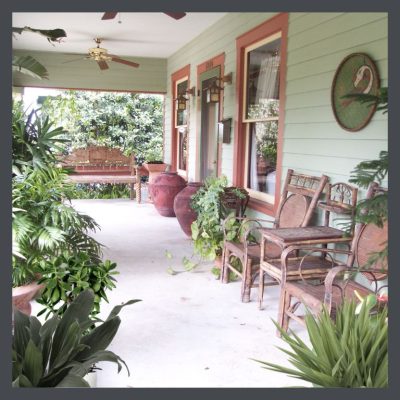 The neighborhoods pitched in, volunteering their bungalows for the project. I recruited writers for all the articles & each author (or group of authors) gathered material & researched their areas.
The neighborhoods pitched in, volunteering their bungalows for the project. I recruited writers for all the articles & each author (or group of authors) gathered material & researched their areas.
My neighborhood, Seminole Heights produced some beautiful houses & the authors encouraged a woman who had lived in the neighborhood in the early years to tell her story- A Place to Grow Up. Her sweet childhood voice & photos brought those times to life. I am lucky enough to have another story from her to tell you here, Childhood Pets in My Bungalow Neighborhood.
The article tells the story of how the neighborhood association began- a response to the threatened destruction of many bungalows along one of our central corridors. By the time I arrived 25 years later, it was a powerful force for preservation & revitalization. When I say, “Do something about it,” I have seen firsthand what can be done by a group of committed citizens.
The neatest part about the in article occurred when the editor sent me a proof & there was my front porch in a 2-page color spread opening a piece in my favorite magazine, American Bungalow! There were a couple shots of my living room too, but they were pretty small. Finally, at the age of 60 my dream of being a centerfold was realized! And it was one that I could show my mother!
AMERICAN BUNGALOW MAGAZINE VISITS A HISTORIC FARMHOUSE IN YBOR CITY
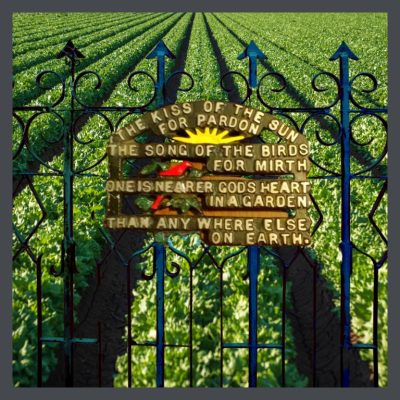 In the center of Tampa is a farm with a bungalow farmhouse, built by Sicilian immigrants, Salvatore & Vittoria Giunta, who arrived in Tampa in 1907. Peasant farmers, they hoped for a better life for themselves & their children in American. Work was plentiful in Ybor City in the cigar factories & farms & they worked at a variety of jobs, saving money until they could buy land. Self-sufficient, they raised heirloom vegetables & herbs with which they fed their family & sold the surplus to supplement their income. At one time, this area, now residential was dubbed “the breadbasket of Ybor,” providing food for up to 10,000 cigar factory workers. After time they purchased more land & in 1924, the house was built just in time for the family to enjoy their Christmas together. The farm up to this day, almost 100 years later, is still being worked by the two granddaughters, who live in the old farmhouse.
In the center of Tampa is a farm with a bungalow farmhouse, built by Sicilian immigrants, Salvatore & Vittoria Giunta, who arrived in Tampa in 1907. Peasant farmers, they hoped for a better life for themselves & their children in American. Work was plentiful in Ybor City in the cigar factories & farms & they worked at a variety of jobs, saving money until they could buy land. Self-sufficient, they raised heirloom vegetables & herbs with which they fed their family & sold the surplus to supplement their income. At one time, this area, now residential was dubbed “the breadbasket of Ybor,” providing food for up to 10,000 cigar factory workers. After time they purchased more land & in 1924, the house was built just in time for the family to enjoy their Christmas together. The farm up to this day, almost 100 years later, is still being worked by the two granddaughters, who live in the old farmhouse.
Though the farm is a prime piece of property in a very desirable location the sisters stand firm against offers from developers & in 2020, City Council agreed with their request to designate the farm a historic landmark offering some protection against future development. Please watch this beautiful video to learn more about the history of the family & the farm & best of all, to meet the sisters.
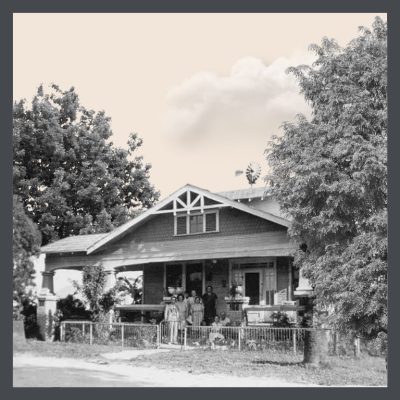 Make no mistake about it. This is a farmhouse. The floors are not glossy quartersawn oak but are covered with linoleum & the usual Stickley pieces that you see pictured in American Bungalow are not in evidence. I spent 2 days helping the sisters stage the house for the shoot (No, Alex didn’t know about know this!) I pulled all the family antiques- a charming deco armoire, an old tricycle, a child’s chair, from the bedrooms & arranged them in the family gathering room off the kitchen. A century ago. their father had made a wooden boat to sail down the flooded Tampa streets, & I pulled it from a closet & had a shelf built for it to be mounted over a quilt-covered chair in the corner.
Make no mistake about it. This is a farmhouse. The floors are not glossy quartersawn oak but are covered with linoleum & the usual Stickley pieces that you see pictured in American Bungalow are not in evidence. I spent 2 days helping the sisters stage the house for the shoot (No, Alex didn’t know about know this!) I pulled all the family antiques- a charming deco armoire, an old tricycle, a child’s chair, from the bedrooms & arranged them in the family gathering room off the kitchen. A century ago. their father had made a wooden boat to sail down the flooded Tampa streets, & I pulled it from a closet & had a shelf built for it to be mounted over a quilt-covered chair in the corner.
In the kitchen sits a “Nana cabinet,” a traditional Sicilian piece in which were displayed the china, glassware & collectables of the grandmother of the house. This one was built by her son of recycled materials—wood slats from apple crates, curved glass sides from a discarded retail display case & the best part- it is topped with a decorative crown from an old circus wagon offered by a friend who just didn’t think that the cabinet looked complete.
The pieces were just stacked in the cabinet, with no attempt to display them. We spent several hours removing the items, carefully placing them on the kitchen table. I returned them one by one, showing each one to full advantage. These pieces hold the memories of family dinners of 3 generations & deserved to be elegantly celebrated.
The sisters are not artists. They are revered teachers, beloved daughters, dutiful sisters & aunts & hard-working farmers. They were astonished at how I managed to honor their family by displaying their heirlooms & photographs artfully.
It was one of the most wonderful experiences of my life.
The morning after John’s event in my neighborhood of Seminole Heights, he & I went for breakfast at the farm. John toured the house & admired the fields, lush with produce whose seeds were brought from Sicily 100 years before. He played fetch with the farm dog & chatted with the chickens. He was honored to have met the Giunta sisters & honored them in return with this beautiful article.
THE AMERICAN BUNGALOW MAGAZINE PHILOSOPHY
“…it’s not about how big you live, it’s about how genuine you live. That’s what the magazine stands for.” – John Brinkmann, American Bungalow Magazine
I was thrilled to be able to provide him with the opportunity to visit a family that had lived so genuinely in their farmhouse bungalow for 3 generations.
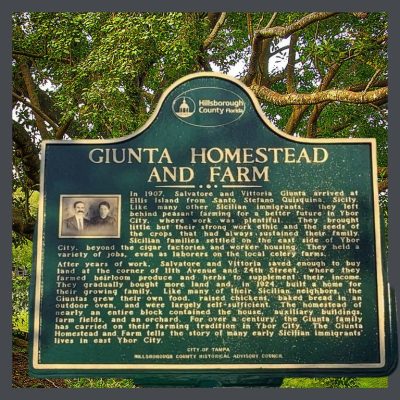 The plaque installed by the City reads:
The plaque installed by the City reads:
In 1907, Salvatore and Vittoria Giunta arrived at Ellis Island from Santo Stefano, Qisquina, Sicily. Like many other Sicilian immigrants, they left behind peasant farming for a better future in Ybor City where work was plentiful. They brought little but their strong work ethic and the seeds of the crops that had always sustained their family. Sicilian families settled on the east side of Ybor beyond the cigar factories and worker housing. They held a variety of jobs, even as laborers on the local celery farms.
After years of work, Salvatore and Vittoria saved enough to buy land at the corner of 11th Avenue and 24th Street, where they farmed their heirloom produce and herbs to supplement their income. They gradually bought more land, and in 1924, built a home for their growing family. Like many of their Sicilian neighbors, the Giuntas grew their own food, raised chickens, baked bread in an outdoor oven, and were largely self-sufficient. The homestead of nearly an entire block contained the house, auxiliary buildings, farm fields and a orchard. For over a century the Giunta family has carried on their farming tradition in Ybor City. The Giunta homestead and farm tells the story of many Sicilian immigrants’ live in Ybor City.
TIP: READ MORE ABOUT MY WILD PRESERVATION LIFE HERE.
 STAY IN THE BUNGALOW KNOW!!!
STAY IN THE BUNGALOW KNOW!!!
Sign up for our newsletter & receive our FREE E-book, 7 VITAL Things to Do Before You Hire a Contractor.

 From their framing to their siding to their doors & windows to their built-ins & their flooring, our old houses, are built of old growth wood. Thousands of board feet of it.
From their framing to their siding to their doors & windows to their built-ins & their flooring, our old houses, are built of old growth wood. Thousands of board feet of it. Let’s start with the Redwood, one class being the oldest plants on earth, living from about 800 to 3,200 years. On the west coast, before they were chopped to build our houses, they played an important part in the lives of early indigenous peoples who revered them, building structures from fallen trees. Native elder Minnie Reeves called them “a special gift from the Great Creator. Destroy these trees and you destroy the Creator’s love . . . and you will eventually destroy mankind.”
Let’s start with the Redwood, one class being the oldest plants on earth, living from about 800 to 3,200 years. On the west coast, before they were chopped to build our houses, they played an important part in the lives of early indigenous peoples who revered them, building structures from fallen trees. Native elder Minnie Reeves called them “a special gift from the Great Creator. Destroy these trees and you destroy the Creator’s love . . . and you will eventually destroy mankind.” The Domesday Book of 1086, a survey ordered by William the Conqueror to record his holdings, indicated a forest cover of 15%, By the start of the next millennium, this coverage had dropped to 5%.
The Domesday Book of 1086, a survey ordered by William the Conqueror to record his holdings, indicated a forest cover of 15%, By the start of the next millennium, this coverage had dropped to 5%.  Trees are planted in man-made forests with the purpose of generating a large amount of product, fast. These farms do not replicate the ecology of the natural forest. Generally they are one species only, & all the trees are planted at the same time. The trees are planted in rows spaced to allow maximum sunlight & water exposure so they grow very fast. The old forests allowed trees to grow slowly, putting on more tightly-packed growth rings
Trees are planted in man-made forests with the purpose of generating a large amount of product, fast. These farms do not replicate the ecology of the natural forest. Generally they are one species only, & all the trees are planted at the same time. The trees are planted in rows spaced to allow maximum sunlight & water exposure so they grow very fast. The old forests allowed trees to grow slowly, putting on more tightly-packed growth rings STAY IN THE BUNGALOW KNOW!!!
STAY IN THE BUNGALOW KNOW!!!

 Much of this mutual adaptation involves microorganisms, the fungi that break down the fiber of the dead trees & turn them into nutritious soil, but also form a communication network for the trees. Watch this short
Much of this mutual adaptation involves microorganisms, the fungi that break down the fiber of the dead trees & turn them into nutritious soil, but also form a communication network for the trees. Watch this short 
 The
The  I also used the same rocks to form a path from the driveway to the front walk. I installed baby’s tears (Soleirolia soleirolii) a mossy appearing tropical perennial with tiny, tiny leaves between the path & the border. They were very soft & sweet & I coaxed them to grow so that they would provide a natural woodland look. A week before my mother was supposed to arrive to see the house for the first time, my gardener edged them so they were level on top & flat against the border. I am a plant whisperer but I admit that during that week I was more of a plant cheerleader & probably even a plant sergeant, alternating cheering & commanding them to grow back into gentle, fluffy mounds before my mom’s arrival.
I also used the same rocks to form a path from the driveway to the front walk. I installed baby’s tears (Soleirolia soleirolii) a mossy appearing tropical perennial with tiny, tiny leaves between the path & the border. They were very soft & sweet & I coaxed them to grow so that they would provide a natural woodland look. A week before my mother was supposed to arrive to see the house for the first time, my gardener edged them so they were level on top & flat against the border. I am a plant whisperer but I admit that during that week I was more of a plant cheerleader & probably even a plant sergeant, alternating cheering & commanding them to grow back into gentle, fluffy mounds before my mom’s arrival. The centered, front-gabled porch is supported by massive timber framing & arroyo stone piers. A free-form arroyo stone chimney is on the east side. Sadly, I have no pictures of my chimney, but you can see it in Jane Powell’s book BUNGALOW DETAILS: Exterior, on page 57. It’s chunky!
The centered, front-gabled porch is supported by massive timber framing & arroyo stone piers. A free-form arroyo stone chimney is on the east side. Sadly, I have no pictures of my chimney, but you can see it in Jane Powell’s book BUNGALOW DETAILS: Exterior, on page 57. It’s chunky!
 Admitted to the Los Angeles County Bar Association in 1912, Hare founded the large & successful law firm of Hare & Walden situated in downtown Los Angeles, which was connected by trolley to Eagle Rock. The little home office, with its built-in desk & fireplace was probably well-used by Hare, writing sermons, counseling parishioners & then, after he began practicing law, working on cases that he brought home from the office so that he could be with his wife, Grace.
Admitted to the Los Angeles County Bar Association in 1912, Hare founded the large & successful law firm of Hare & Walden situated in downtown Los Angeles, which was connected by trolley to Eagle Rock. The little home office, with its built-in desk & fireplace was probably well-used by Hare, writing sermons, counseling parishioners & then, after he began practicing law, working on cases that he brought home from the office so that he could be with his wife, Grace. The public areas were clearly designed for entertaining with a large living room & dining room, as well as a sunroom. I can easily imagine gay fundraisers for the
The public areas were clearly designed for entertaining with a large living room & dining room, as well as a sunroom. I can easily imagine gay fundraisers for the 
 It’s not easy to stay healthy when restoring an old house. Increased demands on your time, your finances, the
It’s not easy to stay healthy when restoring an old house. Increased demands on your time, your finances, the  My grandmother, Sarah Emmeline Martz was a farmer’s wife who cooked for her family every day & tossed the slop to the pigs. During one season of household sniffles she noticed how healthy the oinksters were, compared to her own family, & considered what was in that slop. What she noticed was that she was giving the piggies the outsides of the food- the peels, the parts that grew in closest contact with the soil of her garden. Being a farmer’s wife, she knew where the nourishment for plants came from- the soil- & wondered if maybe she was throwing out the most nutritious part of her family’s food.
My grandmother, Sarah Emmeline Martz was a farmer’s wife who cooked for her family every day & tossed the slop to the pigs. During one season of household sniffles she noticed how healthy the oinksters were, compared to her own family, & considered what was in that slop. What she noticed was that she was giving the piggies the outsides of the food- the peels, the parts that grew in closest contact with the soil of her garden. Being a farmer’s wife, she knew where the nourishment for plants came from- the soil- & wondered if maybe she was throwing out the most nutritious part of her family’s food. The answer is in the beneficial tiny living beings – microorganisms- that live in and on our bodies, especially our guts. Each one of us harbors a unique set, our own community of microorganisms- our microbiota- microscopic life. Our own, personal microbiota, our own group of microorganisms differs from that of any other person as much as our own fingerprints do. The effects of our microbiota on our bodies, are diverse & profound. I am going to concentrate on the microbiota living in our guts to address the subject of how to stay healthy when restoring an old house.
The answer is in the beneficial tiny living beings – microorganisms- that live in and on our bodies, especially our guts. Each one of us harbors a unique set, our own community of microorganisms- our microbiota- microscopic life. Our own, personal microbiota, our own group of microorganisms differs from that of any other person as much as our own fingerprints do. The effects of our microbiota on our bodies, are diverse & profound. I am going to concentrate on the microbiota living in our guts to address the subject of how to stay healthy when restoring an old house.
 The reason I’m even proposing the weird idea of painting a bungalow linoleum floor is because lino wears out. Through decades of footsteps in some of the highest traffic areas of the house, roller skates & doggy toenails, abrasion can annihilate the printed pattern leaving you with a rough, gray surface. Even worse, age can uncover sections of the jute or burlap base, & even one layer down, the mastic that glued it to the subsurface. Adding to the delight are the ineradicable stains of unknown origin. (A whole chicken maybe? They are dang slippery.)
The reason I’m even proposing the weird idea of painting a bungalow linoleum floor is because lino wears out. Through decades of footsteps in some of the highest traffic areas of the house, roller skates & doggy toenails, abrasion can annihilate the printed pattern leaving you with a rough, gray surface. Even worse, age can uncover sections of the jute or burlap base, & even one layer down, the mastic that glued it to the subsurface. Adding to the delight are the ineradicable stains of unknown origin. (A whole chicken maybe? They are dang slippery.) In 1980, I had noticed that any paint I got on the very old & worn (& hideous & impossible to clean) lino floor in my rented bungalow, was too stubborn to remove, I thought, “Gee, I could paint this puppy!”
In 1980, I had noticed that any paint I got on the very old & worn (& hideous & impossible to clean) lino floor in my rented bungalow, was too stubborn to remove, I thought, “Gee, I could paint this puppy!” Even though I had done this process successfully, material formulas have changed radically in the past 40 years (bad) due to environmental concerns (good). Additionally, having painted no design to my 80’s floor, I had ended up with a very flat paint surface. (I used a stenciled canvas floor cloth to make a faux lino rug to fancy it up.) And, I was married to a chemistry major who had sanded & coated 1,000+ floors & was using perfectly calibrated, state-of-art equipment. I’m thinkin’ that maybe you don’t have someone living in your home with these qualifications, nor this equipment (though I’m sure he has his own fine equipment.) So, I wanted to check out these aspects with Earl, my tech guy at Ben Moore, for advice on the painting of a bungalow’s linoleum floor. Earl immediately said, “Don’t do it.”
Even though I had done this process successfully, material formulas have changed radically in the past 40 years (bad) due to environmental concerns (good). Additionally, having painted no design to my 80’s floor, I had ended up with a very flat paint surface. (I used a stenciled canvas floor cloth to make a faux lino rug to fancy it up.) And, I was married to a chemistry major who had sanded & coated 1,000+ floors & was using perfectly calibrated, state-of-art equipment. I’m thinkin’ that maybe you don’t have someone living in your home with these qualifications, nor this equipment (though I’m sure he has his own fine equipment.) So, I wanted to check out these aspects with Earl, my tech guy at Ben Moore, for advice on the painting of a bungalow’s linoleum floor. Earl immediately said, “Don’t do it.” You are about to become a paint expert. This will serve you well as an old house owner because this is not the only time that you will be dealing with applying paint. And if you want to know more, you can go
You are about to become a paint expert. This will serve you well as an old house owner because this is not the only time that you will be dealing with applying paint. And if you want to know more, you can go  If you apply a second coat on when your first is just dry to the touch- not cured- you will get a chemical bond between the 2 coats. As the water (binder) evaporates, the like chemicals of the pigment & the binder will be attracted to each other & form what could be considered a single coat. It’s a very strong bond.
If you apply a second coat on when your first is just dry to the touch- not cured- you will get a chemical bond between the 2 coats. As the water (binder) evaporates, the like chemicals of the pigment & the binder will be attracted to each other & form what could be considered a single coat. It’s a very strong bond. 0. Mend any boo-boo’s. I am not going to try to teach you to do this because I have never mended a floor. I am going to suggest some links of pages that look like they might know what they’re talking about.
0. Mend any boo-boo’s. I am not going to try to teach you to do this because I have never mended a floor. I am going to suggest some links of pages that look like they might know what they’re talking about.
 What seems like a lifetime ago, with a great amount of help from my friends in the 3 areas that make up the bungalow neighborhood of Seminole Heights, in Tampa, Florida, I produced an American Bungalow Magazine event. I had coaxed, cajoled, pleaded with the editor to have genius photographer, Alex Vertikoff come to Central Florida to shoot our houses. I coordinated with 4 other neighborhoods in Tampa, St. Petersburg & Lakeland to make it worth their while to drive all the way across the country. Publisher John Brinkmann came to speak to us at a wonderful event in our historic church.
What seems like a lifetime ago, with a great amount of help from my friends in the 3 areas that make up the bungalow neighborhood of Seminole Heights, in Tampa, Florida, I produced an American Bungalow Magazine event. I had coaxed, cajoled, pleaded with the editor to have genius photographer, Alex Vertikoff come to Central Florida to shoot our houses. I coordinated with 4 other neighborhoods in Tampa, St. Petersburg & Lakeland to make it worth their while to drive all the way across the country. Publisher John Brinkmann came to speak to us at a wonderful event in our historic church. The neighborhoods pitched in, volunteering their bungalows for the project. I recruited writers for all the articles & each author (or group of authors) gathered material & researched their areas.
The neighborhoods pitched in, volunteering their bungalows for the project. I recruited writers for all the articles & each author (or group of authors) gathered material & researched their areas. In the center of Tampa is a farm with a bungalow farmhouse, built by Sicilian immigrants, Salvatore & Vittoria Giunta, who arrived in Tampa in 1907. Peasant farmers, they hoped for a better life for themselves & their children in American. Work was plentiful in Ybor City in the cigar factories & farms & they worked at a variety of jobs, saving money until they could buy land. Self-sufficient, they raised heirloom vegetables & herbs with which they fed their family & sold the surplus to supplement their income. At one time, this area, now residential was dubbed “the breadbasket of Ybor,” providing food for up to 10,000 cigar factory workers. After time they purchased more land & in 1924, the house was built just in time for the family to enjoy their Christmas together. The farm up to this day, almost 100 years later, is still being worked by the two granddaughters, who live in the old farmhouse.
In the center of Tampa is a farm with a bungalow farmhouse, built by Sicilian immigrants, Salvatore & Vittoria Giunta, who arrived in Tampa in 1907. Peasant farmers, they hoped for a better life for themselves & their children in American. Work was plentiful in Ybor City in the cigar factories & farms & they worked at a variety of jobs, saving money until they could buy land. Self-sufficient, they raised heirloom vegetables & herbs with which they fed their family & sold the surplus to supplement their income. At one time, this area, now residential was dubbed “the breadbasket of Ybor,” providing food for up to 10,000 cigar factory workers. After time they purchased more land & in 1924, the house was built just in time for the family to enjoy their Christmas together. The farm up to this day, almost 100 years later, is still being worked by the two granddaughters, who live in the old farmhouse. Make no mistake about it. This is a farmhouse. The floors are not glossy quartersawn oak but are covered with linoleum & the usual Stickley pieces that you see pictured in American Bungalow are not in evidence. I spent 2 days helping the sisters stage the house for the shoot (No, Alex didn’t know about know this!) I pulled all the family antiques- a charming deco armoire, an old tricycle, a child’s chair, from the bedrooms & arranged them in the family gathering room off the kitchen. A century ago. their father had made a wooden boat to sail down the flooded Tampa streets, & I pulled it from a closet & had a shelf built for it to be mounted over a quilt-covered chair in the corner.
Make no mistake about it. This is a farmhouse. The floors are not glossy quartersawn oak but are covered with linoleum & the usual Stickley pieces that you see pictured in American Bungalow are not in evidence. I spent 2 days helping the sisters stage the house for the shoot (No, Alex didn’t know about know this!) I pulled all the family antiques- a charming deco armoire, an old tricycle, a child’s chair, from the bedrooms & arranged them in the family gathering room off the kitchen. A century ago. their father had made a wooden boat to sail down the flooded Tampa streets, & I pulled it from a closet & had a shelf built for it to be mounted over a quilt-covered chair in the corner. The plaque installed by the City reads:
The plaque installed by the City reads: